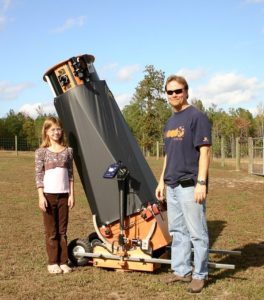In the beginning, the night sky was full of holes, or pixie dust, or whatever.
At some time in the distant past, I have no idea when, somebody figured out what stars are. It took longer to realize how far away they are. People began getting a closer look at them, and the planets, beginning in 1608 when the first telescopes were made, but the early discoveries were gradual and hit-or-miss.
For many years, astronomy was done almost entirely by well-heeled amateurs. Governments weren’t interested in funding anything not useful for navigation or other practical applications (such as crop planting). The early scientific discoveries were made by so-called Grand Amateurs, who were aristocrats or rich entrepreneurs who could afford to have telescopes built and had estates to park them on. (For a competent history of astronomy from then to the present, get this book.)
Today, scientific astronomy is done by about 50,000 professional astronomers worldwide, using billion-dollar research telescopes. Nobody looks through them; they’re data-collecting devices fitted with cameras and other instruments. There may be several million amateur astronomers, ranging from casual stargazers to serious hobbyists, but the science has progressed way beyond the capabilities of amateurs and amateur equipment, and for them it’s just a hobby now.
There’s not all that much to see by looking through telescopes anyway. Cameras see much better than the human eye. That’s why even hobbyists are into imaging. With expensive equipment, long time exposures, and layering multiple images on top of each other using computer technology and software, they can get impressive photos of planets, moons, galaxies, and nebulae. You won’t see anything like the pictures by looking through a telescope, not even a high-end one. Visual views better than smudges are achievable, but you get what you pay for, and good telescopes aren’t cheap.
There are two basic types of telescopes, refractors and reflectors. In a refractor telescope, light passes straight through magnifying lenses. Reflectors use mirrors, which can be larger to capture more light, and direct it through lenses. Each type of telescope has its idiosyncrasies. Refractors are easier to use, because reflectors require more tinkering and adjusting. but are more expensive per inch of aperture diameter because lenses cost more to make. A refractor the same size as a larger amateur reflector would be hopelessly expensive, so generally speaking you need a reflector for anything requiring larger aperture.
Aperture is the diameter of the light-capturing surface. The bigger the aperture, the more light, and the more you can see. Bigger aperture produces brighter images with sharper detail and can be magnified more. Quality of the optics is a big factor, too; better quality costs more money. The quality of the night sky also is a major factor in how much you can see. You can’t see anything through clouds or smoke, and light pollution is a problem in most places. Dedicated amateurs often will travel long distances to get clear and unpolluted skies.
Amateur astronomy is a night-time activity, conduced outdoors (for obvious reasons), which means lost sleep and maybe freezing your butt off. Do you really want to do this?
As for what you can see, when looking through a good telescope in good visibility (“seeing”) conditions, a star is simply a larger round blob of white light. Nothing to see there. Amateurs mostly look at the moon and planets, and if their equipment is good enough and the sky is dark enough, deep space objects like galaxies.
Because the earth is rotating, you’re looking at moving objects. This can be overcome with a tracking mount, but those are expensive and heavy. For imaging, which requires time-exposures, they’re a necessity. The telescope itself also can be quite heavy, especially a larger reflector. Weight, along with expense, is a limiting factor on telescope size, and therefore what you can see as an amateur astronomer.
I’m not one, I’ve never been in the hobby, and I don’t own a telescope. Just a cheap pair of binoculars for general daytime use. I can’t hold it steady enough to get a decent view of the moon with it. A cheap tripod would help, but I haven’t bothered. If I want to stargaze it’s easier, more comfortable, and vastly cheaper to look at Hubble photos on my computer. Hey, I’m not knocking the hobby; it’s a fine pastime, if you have the time and inclination, and can afford it.
 Photo: You can see galaxies in a good night sky with this Obsession Classic 18″ dobsonian reflector telescope, but it costs $8,000 without accessories (easily over 10 grand fully equipped), you’ll wait a year for delivery, and it weighs over 100 lbs. The mirror requires cooling fans, and you’ll frequently have to adjust (“collimate”) it. This level of amateur astronomy is very much a hobby for gearheads, because you’ll spend more time tinkering with equipment than looking at sky objects that were discovered long before you were born, and have been thoroughly photographed and analyzed.
Photo: You can see galaxies in a good night sky with this Obsession Classic 18″ dobsonian reflector telescope, but it costs $8,000 without accessories (easily over 10 grand fully equipped), you’ll wait a year for delivery, and it weighs over 100 lbs. The mirror requires cooling fans, and you’ll frequently have to adjust (“collimate”) it. This level of amateur astronomy is very much a hobby for gearheads, because you’ll spend more time tinkering with equipment than looking at sky objects that were discovered long before you were born, and have been thoroughly photographed and analyzed.